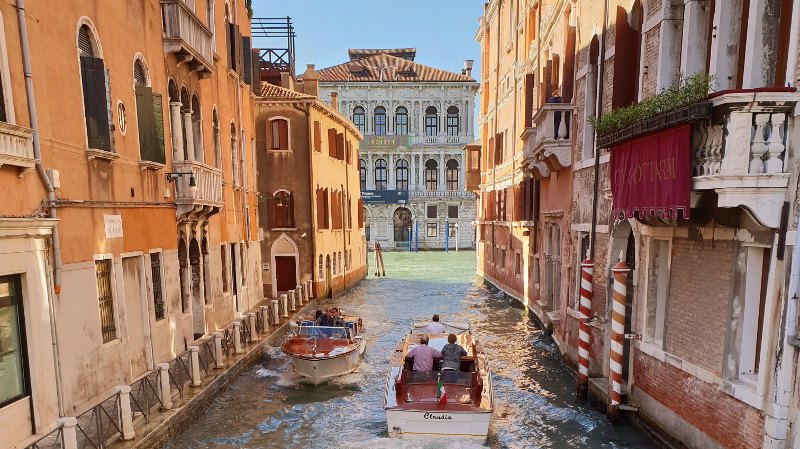Friday 5th October marked the last full day of our short break in Venice. Much like the previous day, it would involve sightseeing in Venice, except, this time, we’d be checking out the sights of Venice and Murano Island. Also, much like the previous day, it started at around 9 am with a leisurely breakfast at our hotel, the Antica Fenice.
The Antica Fenice, incidentally, is an excellent hotel and I heartily recommend it. It’s on the main road from the airport to Venice Island. It’s also located opposite a Lidl supermarket, which is open seven days a week and the ideal place to get all your drinks and snacks. Additionally, it is very close to the bus stop for the numbers 5 and 19 buses, which get you to Venice Island in about 10 minutes. The staff speak excellent English. The breakfast is tasty and filling, and the rooms are both clean and bigger than expected. It also advertises that it has a restaurant, but this wasn’t the case during our stay, more of which later.
Having visited the Rialto Bridge, St Mark’s Square and the Bridge of Sighs during day one, the second day would focus on the North of Venice and Murano Island. The planned itinerary was:
- Bus Station
- Through Cannaregio Sestieri to the Fondamente Nove water bus stop
- Water bus to Murano, for a damn good explore
- Back to Cannaregio Sestieri (via water bus)
- Stroll through Santa Croce Sestieri
- To get back to the bus station
Much like in my previous post, I won’t attempt to describe the exact route we took from the Bus Station to Fondamente Nove, for very much the same reasons:
- The route took us past so many notable objects, that noting them all becomes counterproductive;
- I can’t describe the exact route we took because I kept losing track of where we were, and;
- With so much to see, it doesn’t make sense to retrace what we did; all routes are good routes.
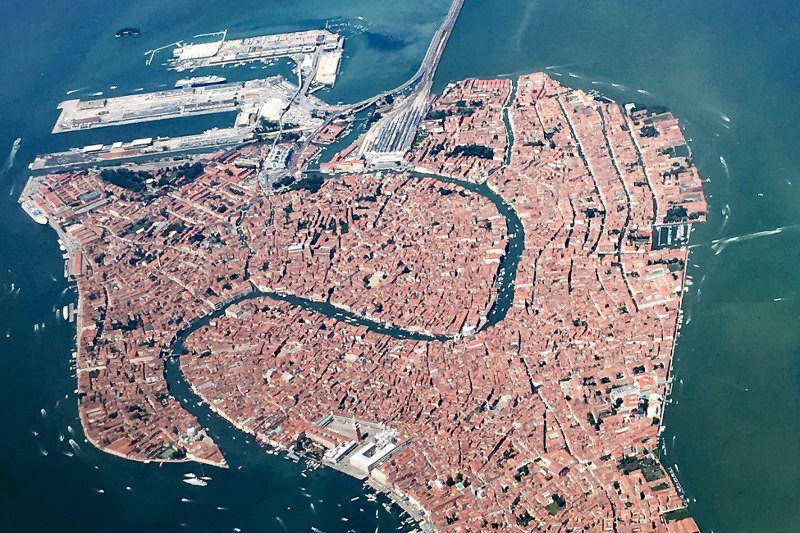
Besides, the original route I had in mind went to pot very quickly. Having set off over the Constitution Bridge and past the Train Station, we crossed over a bridge and saw a sign for the Ghetto. Having spotted the sign, I was fascinated. I immediately assumed that it was applying the colloquial meaning of the word, ‘a slum area’. I just had to know what constituted a ‘slum’ in a city like Venice and dragged poor Julie off to find out. After all, we did have time to turn our Venice and Murano day into a Venice, Murano and slum day. Plus; why was the city advertising its slum?! I had to know…
Upon inspection, it was very much a different sort of ‘Ghetto’! Maybe even the original Ghetto. You see, the full colloquial meaning of ghetto is, ‘a slum area, occupied by a minority group.’ The minority group in this instance, was the Jewish. This was the area in which the Jewish people had been compelled to live by the Venetian Republic, way back in 1516. Thus, the historical meaning of ghetto is: Jewish area, or Jewish quarter. Which is what we found.
In practical terms, the Ghetto was much the same as the rest of the city, which is to say, very far from a slum. Visually, the main differences were that the churches were replaced by synagogues and the shop names were prefixed with the word ‘Jewish’. Hence, Bakery became Jewish Bakery, etc. The feel and style of the Ghetto was largely in keeping with the rest of the city. It was a nice surprise to find, though. Venice was very good at throwing up surprises.
Another case in point happened less than half an hour later. After working our way closer to Fondamente Nove, to get to the Murano half of our Venice and Murano day, we spotted a sign offering, ‘Time Space Existence‘. Well, we couldn’t resist an offer like that, and headed into Palazzo Bembo to see what was there. I think we were expecting something physics, astronomy and space related. What we got was: the fourth edition of the biennial architecture exhibition, hosted by the European Cultural Centre. I actually have an interest in architecture. Julie really, really does not. But we had a look around and took a photo…
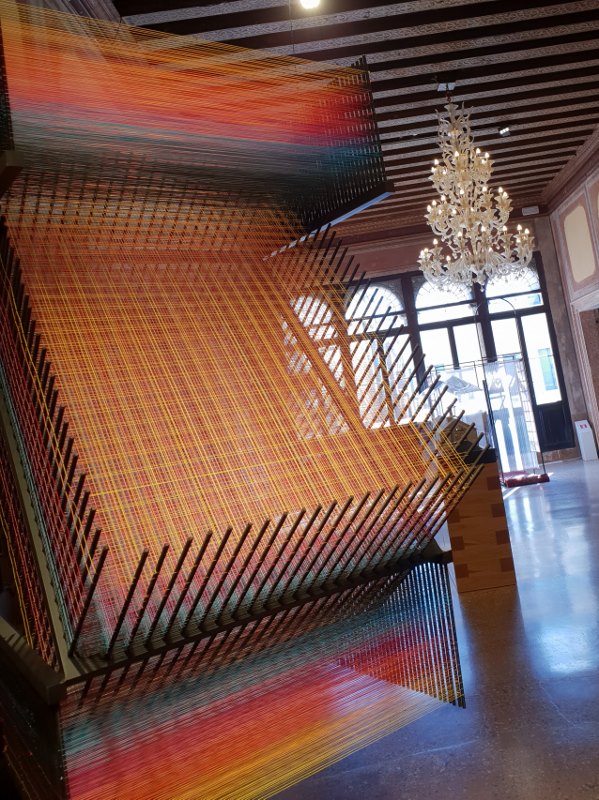
Back on the street, pausing only briefly for a hot drink to fortify ourselves, we made it to the water bus stop at Fondamente Nove. Then it was simply a case of catching the right water bus to get us to Murano…
Which brings us neatly to Water Buses, and how they work. There are water bus stops dotted all around the outside of the islands, as well as up and down the Grand Canal. And, much like their terrestrial counterparts, water buses have both routes and time tables. Also, like buses on land, water buses have their route letter, or number, clearly shown on their outside. Also, sometimes, the stops along the route are displayed.
It’s worth knowing that some routes are circular and some are linear. Routes 4.1 and 5.1 go around the island in a anticlockwise direction, while routes 4.2 and 5.2 travel clockwise. Route 1, however, goes from Lido (SME) D to Piazzale Roma D (Parisi) and back again. This means two things:
- Some stops on Route 1 will collect passengers travelling in either direction, meaning you can end up going exactly the wrong way.
- ‘D’ means ‘D’. Some of these water bus stops are spread over a large area. The stops at Piazzale Roma, for example, go up to ‘G’, plus one for a hotel. Waiting at the ‘B’ station for a ‘D’ bus will not get you were you’re going.
Thankfully, however, the larger water bus stops have a manned booth to help point you in the right direction. Once you know that you’re in the right place, run your travel card over the sensor and move through to the waiting area.
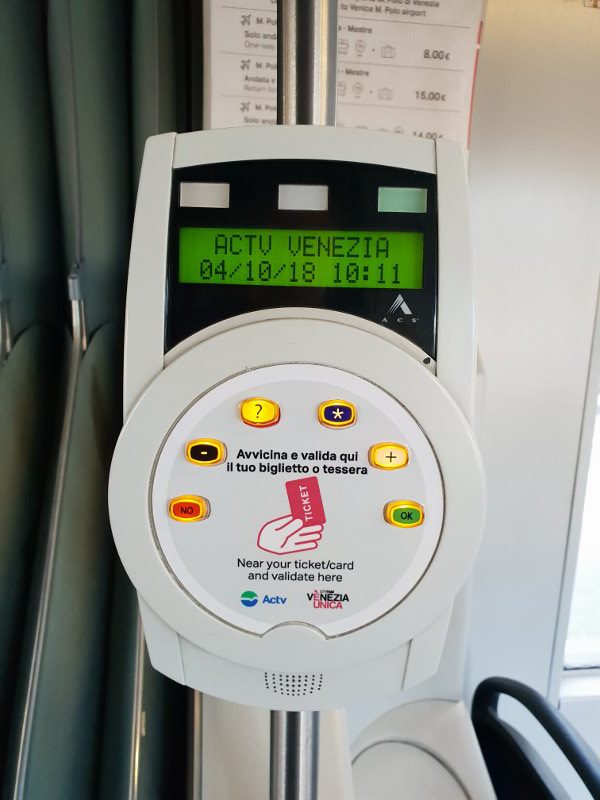
The waiting area is actually afloat, and accessed by a gangplank. This is to allow the waiting area to rise and fall with the water level, making it easier to get on the water bus. That said, I’m glad I didn’t have to try it in stormy conditions…
It’s worth pointing out that these water buses are working buses; they’re not tourist vehicles. As such, they’re designed to get the maximum number of people from A to B, as quickly and efficiently as possible. This means that they’re mainly enclosed, to keep passengers out of the weather. They’re also designed to take a lot of standing passengers, which means that window seats are rare.
There are, though, a number of different designs and some have open spaces at the front. Others have open spaces at the back. It’s worth checking to see if these are present, and available, because you can get some excellent photos from these locations.
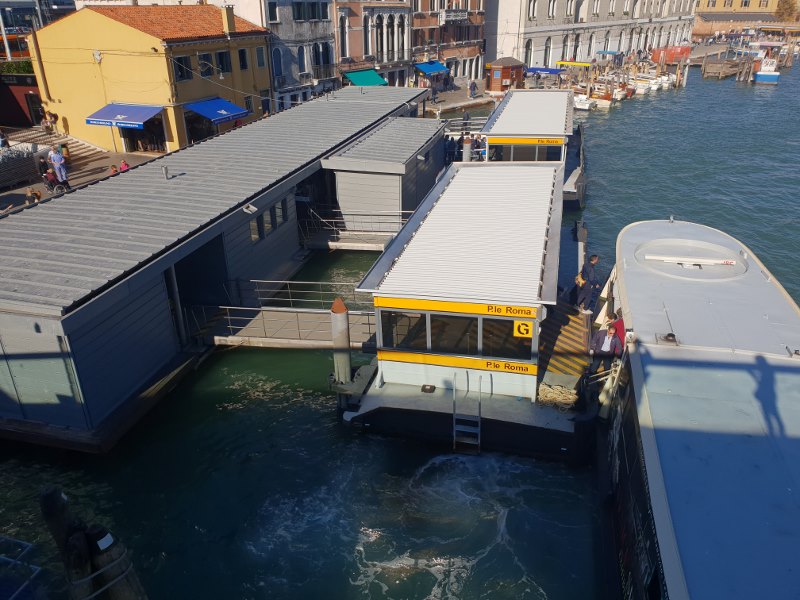
But, back to Fondamente Nove, where we did manage to catch the right water bus, and set off for Murano: the home of Murano Glass. Venice and Murano was on…
We got off at the first stop we arrived at, not wanting to risk ending up on Burano Island. It was the Colonna stop. In retrospect, there were plenty of other stops available to us, and Colonna was one of the furthest from the main shopping area. Not that it mattered; we were not in a rush.
As soon as we disembarked, there were people telling us how to get to Murano Art Glass, where we could watch glass ornaments being made, and advising us of when the tours were running. This was simply a clever marketing ploy. To get to that particular studio, you literally had to walk past several others, which were doing exactly the same thing. Judging by the queue, though, it was an effective marketing technique. And, who knows; maybe it really is something unique. I can’t tell you because we had no intention of queuing, and headed for the shops.
I’d been quite taken by the idea of getting a little glass goldfish in a bowl ornament, by way of a memento of the trip. They were available in many of the tourist shops on the main Venice Island but I decided to wait until we got to Murano to buy one. On Murano, they were in every tourist shop! Of which there were too many to count.
Each of the larger Murano Glass tourist shops seemed to have their own unique piece. In one place it might be a certain type of swallow. In another, it was a penguin. Elsewhere, a style of butterfly. Other than that, the shops all rolled into one. Which isn’t to say we didn’t look in a lot of them. We did. Always searching for the perfect goldfish…
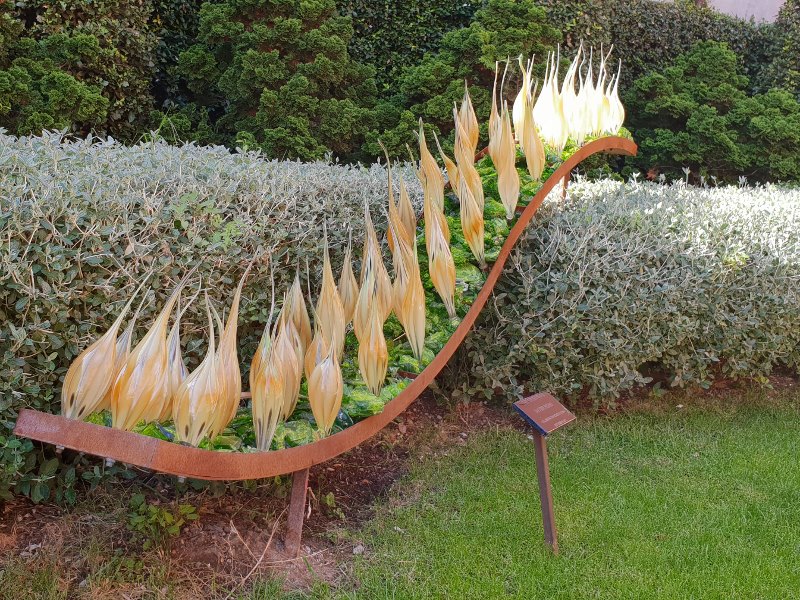
As well as the glass studios and glass shops, there were glass sculptures dotted around the squares and gardens, and even a street performer playing music on water glasses. But there’s only so much glass you can take on an empty stomach, and we needed some lunch.
Having learned from the previous day, about the expense of eating in the heart of tourist areas, we did something else. We crossed over the Ponte Longo bridge onto the next island, and ducked back down the alley, Calle Angelo dal Mistro. The map told me that this led to a square, which I thought looked a likely place to find somewhere reasonable to eat. There were two places, as it turned out. We ate at the one that had seats outside and ordered virtually the same meal we’d had the previous day: a couple of sandwiches and drinks. The price here, though, was less than half the price of the day before. Result!
From there, we explored out and away from the shopping area, and into some more residential areas of Venice and Murano. It was almost strange to see laundry strung between windows after such unrelenting focus on touristic appearances. It was also here that we saw our only domestic cat of the whole trip… that’s not enough cats.
From that relative tranquility, we braved the return to the tourist centre and, on the 568th shop we tried, I found the ideal goldfish:
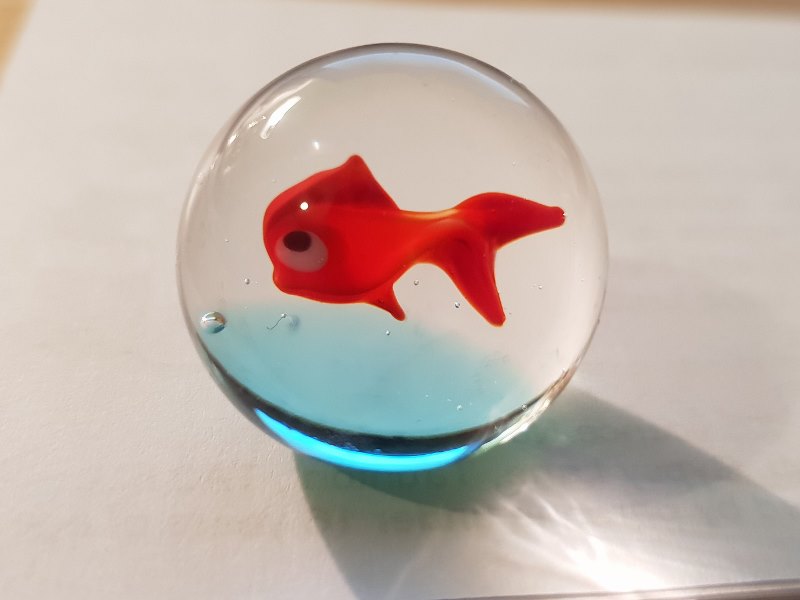
After that, we made our way back to the Colonna stop, and caught the first water bus back to Venice Island. Murano offers some amazing craftsmanship but is very one dimensional, in terms of shopping. In all honesty, I could probably have got a similar goldfish, for less money, on Venice Island. But, for all that; I’m glad we went.
Back at Fondamente Nove, a brief study of the map showed that the only real way to the Santa Croce Sestieri was over the Rialto Bridge. So, that’s what we did, crossed the Rialto Bridge and headed North and West into Santa Croce. This turned out to be another district of historic churches, magnificent architecture, grand squares and bridges. I’m not saying it isn’t impressive but I am saying that after two solid days of Venice and Murano, you become desensitised to the glory. Even the gondolas lose their appeal:
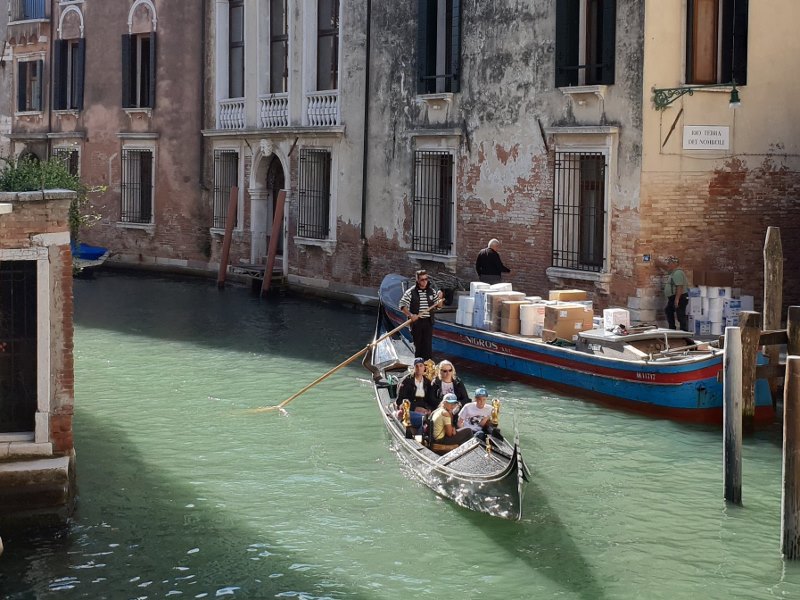
The thing about Gondola rides, other than that they cost are €120 (£88, $113) per hour, is the lack of privacy. The expectation of a couple sharing a romantic ride, cuddling their way down a canal without a care in the world seems improbable. Even forgetting the Venetian gondolier, who is literally standing over you watching your every move, the reality is that you’ve become a tourist attraction. Every bridge you go under will be lined with tourists taking photos of you and saying, ‘Aw, how romantic!’ in their native language. Oddly enough, Julie and I opted against a gondola ride in both Venice and Murano.
And, so, we headed back to the bus station. Pausing only long enough to buy another hot drink and be scammed. While waiting for said hot drink, a guy appeared and tried to sell us a couple of roses. We declined because; what were we going to do with roses? We were flying home the following morning! At that, the guy said we could have them for free as he was packing up for the day anyway. I immediately felt bad and offered him €5, which disappeared, along with the guy, so fast that it left a hole in time and space. The waiter explained that it was a standard scam and rose sellers were something of a problem in Venice and Murano.
He then pointed out the unfairness of how he earned so little and the con artists earned so much. So, of course, I felt obliged to leave a large tip. My large tip for all this is; never accept roses unless you really want them. And, even then, get them from a florist. That’s where the con artists get them…
On a slightly different note: public toilets…
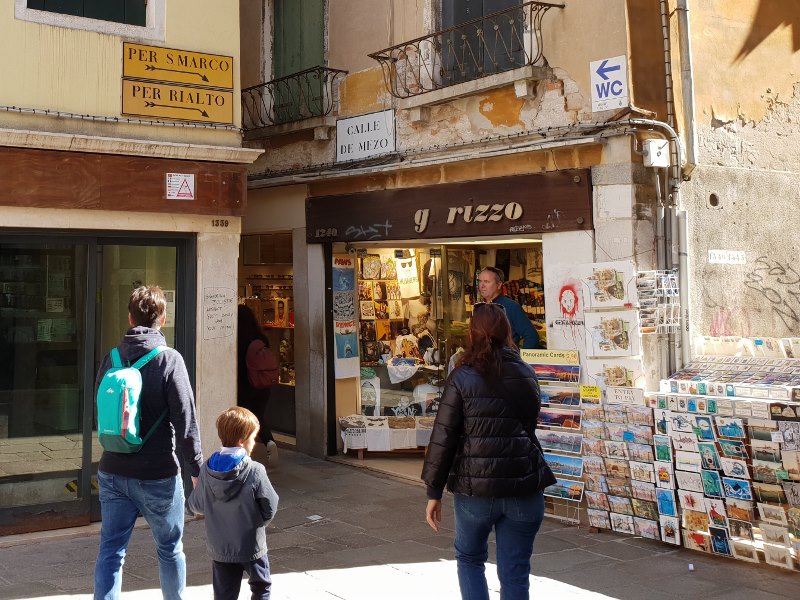
In both Venice and Murano, there seem to be a lack of accessible toilets in public buildings and shops. The city has got round this by ensuring that there are good numbers of public toilets. The signs to these toilets are plentiful and well sited on both walls and floors. When you start looking for them, you can usually find one pretty quickly.
The signs lead to manned facilities that are clean and functional. But are not open 24 hours a day. And are not free. To use one of these toilets costs €1.50, but change is available on site.
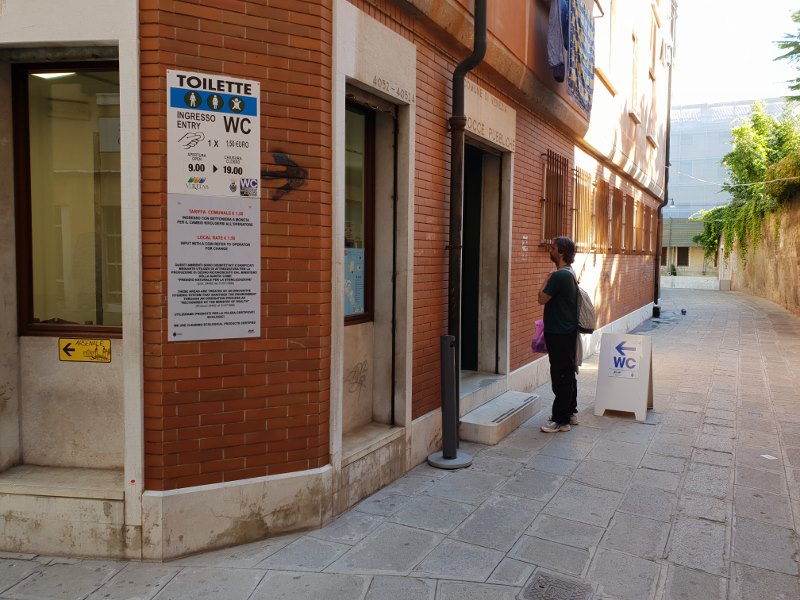
But we weren’t interested in toilets, public or otherwise, we were headed back to the hotel, to find a meal. As I mentioned at the start, the sign for our hotel offered a restaurant. And, by this stage, we had seen enough of Venice and Murano, so a nice relaxing meal back at the hotel seemed ideal. Sadly, the restaurant was not in operation at this stage of the season. Happily, however, the hotel owner had a second business, just up the road; the Colors Restaurant.
We wandered up and it turned out to be more of a pizzeria, attached to the Colors Hotel, than a restaurant. But it was open and, incredibly, could seat us immediately. Admittedly, the seating was outside, and it was far from a warm night, but Julie had wrapped up warm, so we went for it. The food was reasonably priced, tasty and came in huge portions. It’s certainly a place at which I’d be happy to eat again. After a glass or two of wine, we went back to the hotel and packed up for the off, the following morning.
Come the morning, there was one slight problem: the bus to the airport. The travel tickets we’d purchased didn’t cover the trip to the airport. And the tickets on sale at the hotel were only to get to Venice Island. The receptionist explained that we could use the tickets to head towards the airport, but would need to get off a couple of stops early. We could do that.
Or so we thought. As it turned out, there was no real way to work out which the stop before the airport was, until after we’d arrived there. At which point it was like; Ah, it must have been that last one…
Still, the driver either didn’t seem to care. Certainly, she didn’t ask for any more money. And other passengers were trying to get past us to get off the bus, so we hopped off with them, and the bus drove away. It’s nothing I’d recommend, but it was kind of a nice way to end our trip to Venice and Murano; getting something a little cheaper than it should be.
On the whole, Venice is an extremely expensive place to visit. But it’ll certainly keep you thoroughly entertained for at least a couple of days. For us, two days were enough but I’d certainly highly recommend a short trip to Venice in October, to anyone thinking of such.
